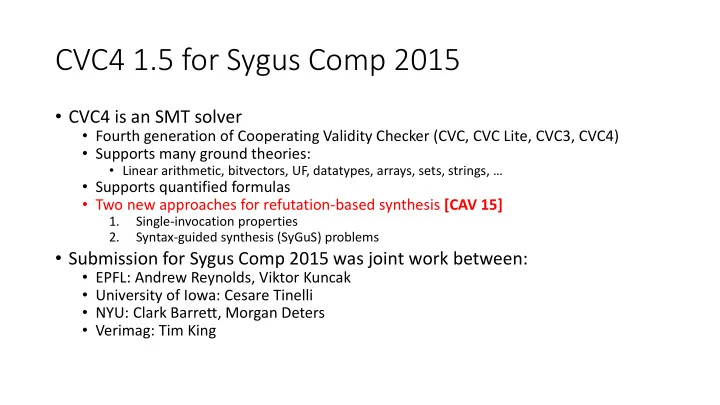

CVC4 1.5 for Sygus Comp 2015 • CVC4 is an SMT solver • Fourth generation of Cooperating Validity Checker (CVC, CVC Lite, CVC3, CVC4) • Supports many ground theories: • Linear arithmetic, bitvectors , UF, datatypes, arrays, sets, strings, … • Supports quantified formulas • Two new approaches for refutation-based synthesis [CAV 15] 1. Single-invocation properties 2. Syntax-guided synthesis (SyGuS) problems • Submission for Sygus Comp 2015 was joint work between: • EPFL: Andrew Reynolds, Viktor Kuncak • University of Iowa: Cesare Tinelli • NYU: Clark Barrett, Morgan Deters • Verimag: Tim King
Refutation-Based Synthesis f. xy.(f(x,y) x f(x,y) y (f(x,y)=x f(x,y)=y)) • Example: find a function f that computes max of two integers
Refutation-Based Synthesis f. xy.isMax(f(x,y),x,y)
Refutation-Based Synthesis f. xy.isMax(f(x,y),x,y) Find model for f that satisfies this property
Refutation-Based Synthesis f. xy.isMax(f(x,y),x,y) Negate f. xy. isMax(f(x,y),x,y) Instead , show negated formula is unsatisfiable
Refutation-Based Synthesis f. xy.isMax(f(x,y),x,y) Negate f . xy. isMax(f(x,y),x,y) • Eliminate second-order quantification over f in two ways
Refutation-Based Synthesis f. xy.isMax(f(x,y),x,y) Negate f. xy. isMax( f(x,y) ,x,y) If single invocation, replace f with (first-order) variable g xy. g . isMax( g ,x,y) g represents the return value of f
Refutation-Based Synthesis f. xy.isMax(f(x,y),x,y) Negate f. xy. isMax( f(x,y) ,x,y) Otherwise, replace f with If single invocation, replace f datatype d , and operator ev with (first-order) variable g xy. g. isMax(g,x,y) D := zero | one | plus( D1, D2 ) | … d . xy. isMax( ev(d,x,y) ,x,y) dxy.ev(d,x,y )=… D models the domain of possible solutions for f
Refutation-Based Synthesis f. xy.isMax(f(x,y),x,y) Negate f. xy. isMax(f(x,y),x,y) Otherwise, replace f with If single invocation, replace f datatype d , and operator ev with (first-order) variable g xy. g. isMax(g,x,y) D := zero | one | plus( D1, D2 ) | … d. xy. isMax(ev(d,x,y),x,y) dxy.ev(d,x,y )=… Single invocation approach Syntax-guided approach
Solving Synthesis Conjectures in an SMT Solver f. xy.isMax(f(x,y),x,y) Quantifiers SMT Solver SAT Solver + Module Dec Procedures
Solving Synthesis Conjectures in an SMT Solver f. xy.isMax(f(x,y),x,y) 1. Negate, convert to first order g. isMax(g,a,b) Quantifiers SMT Solver SAT Solver + Module Dec Procedures
Solving Synthesis Conjectures in an SMT Solver f. xy.isMax(f(x,y),x,y) 1. Negate, convert to first order g. isMax(g,a,b) isMax(a,a,b), isMax(b,a,b), Quantifiers SMT Solver SAT Solver + Module Dec Procedures 2. Add instances until “ unsat ”, unsat via counterexample-guided quantifier instantiation
Solving Synthesis Conjectures in an SMT Solver f. xy.isMax(f(x,y),x,y) 1. Negate, convert to first order g. isMax(g,a,b) isMax(a,a,b), isMax(b,a,b), Quantifiers SMT Solver SAT Solver + Module Dec Procedures 2. Add instances until “ unsat ”, f := l xy. ite(isMax(x,x,y),x,y) unsat via counterexample-guided quantifier instantiation 3. Extract solution for f from unsat core isMax(a,a,b), isMax(b,a,b) ╞
CVC4 in Sygus Comp 2015 • Entered all three tracks (General, LIA, INV) • For general/LIA track: • Most benchmarks are single invocation • Solution reconstruction methods to match syntactic restrictions, if necessary • For INV track: • All benchmarks are not single invocation • Due to form of benchmarks, for transition relations T : inv. x.(inv( x ) T(x,x ’)) inv( x ’ ) Resorts to syntax-guided approach
Recommend
More recommend